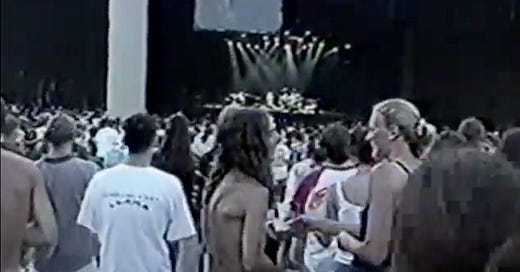SET 1: The Moma Dance > Runaway Jim, Bouncing Around the Room > Tweezer, Strange Design, Cavern
SET 2: Birds of a Feather, Bug, My Sweet One, Run Like an Antelope, Frankie Says, Carini, The Squirming Coil, Prince Caspian
ENCORE: Guyute, The Inlaw Josie Wales, Driver, Tweezer Reprise
Outside of Phish and its Big Cypress triumph, the big news in jambands around the turn of the century was its growing merger with another genre: electronic music. The jam world wasn’t particularly ahead of its time here, with the big beat cultural moment of the Chemical Brothers, The Prodigy, and Fatboy Slim mostly come and gone by 2000. But the jam kids were more hospitable to their raver peers than other genres; while Eminem was yelling “nobody listens to techno” and rap-metal was doubling down on guitars, groups like The Disco Biscuits and Sound Tribe Sector 9 were going all-in on improvisational rock over programmed beats.
There are a lot of reasons why this cross-genre pollination made sense, the obvious top three being 1) drugs, 2) crazy lights, 3) how cool crazy lights look when you’re on drugs. But coming in at a close #4 is the very similar approach to live performance across the two scenes. At its best, improvisational rock provides musicians with the same tools available to a dance-floor DJ: the ability to respond on the fly to crowd energy, to extend a segment that’s working well or flip it up when the vibe starts to sag. Both can provide the ecstatic communal experience of feeling connected to the music and the musician, laced with the thrill of unpredictability. When it’s really working, you don’t even need the lights or the drugs…though I’m told they help.
Phish have been masters of this skill since Mike’s favorite tease “Groove is in the Heart” was the big club-to-radio crossover. But when it comes to the aesthetics of electronic music, they were far more conservative in the late 90s than their jammy peers. The “disco” set at The Great Went is the most forgettable festival late-night by far, best unremembered aside from this GIF. Both Page and Trey bought new synthesizers, but their usage was much more in the vein of Edgar Winter and Bernie Worrell than Giorgio Moroder. They’ll be deep into 3.0 before they start incorporating samples into their live shows, and even deeper when they finally give drum programming a try*.
But while Phish might have largely avoided the aesthetics of electronic dance music, they were all in on the logic of it by 2000. It started coming into focus with last year’s TAB adaptations and has really started to become the dominant jamming style on the other side of the century. On the quieter end, that includes ambient excursions of the sort we got in Japan, but that style is much closer to the Eno/dub roots of electronic music than anything contemporary in the year 2000.
Instead, I hear the dance club in places like tonight’s Tweezer, jams that feel like DJ sets with rock instrumentation. This might be the longest Tweezer that sustains a single mood through the entire runtime; it could fall back into the Tweezer riff at any given moment in the jam. Fishman’s four-on-the-floor drumbeat sounds pretty much the same at minute 22 as at minute 6, and while he naturally includes infinite variations in between, he keeps it within a tight range of tempo and rhythm throughout. Instead of swerving between moods and themes, Page, Mike, and Trey add and remove layers like a producer dragging and dropping samples on top of a steady BPM.
It never stops being interesting or danceable, and there are waves of high and low energy producing peaks of emotional catharsis, like the chipper chords in the 16th minute or the frantic, Leslied-out laser battle when Fish finally kicks it into double time near the end. But it’s a long walk from the Mud Island Tweezer played just five years prior, a jam so multi-segmented I chopped it up into twelve chapters. In 2000, Phish isn’t as interested in dictating a longform story through improvisation or perplexing the audience as much as they reward them, it’s now about keeping the party going and bodies moving.
That’s a controversial shift, even if it happened so gradually over five years it was hard to notice. But Phish’s tasteful borrowing from the electronic trends of the time has definitely aged a lot better than the music of peers who took a deeper dive. On this evening, the Tweezer is a welcome half-hour of focus in an otherwise sloppy show, one that opens with an extended Moma Dance that has nothing interesting to say and concludes with an absurdly flow-less second set and encore** that would clear any dance floor. If there’s something broken in 2000 – and to be honest, it hasn’t really emerged yet – it’s not the subtle influence of electronic music to blame. If anything, the genre is providing a trickle of new ideas that, for now, are staving off the malaise.
* - It’s pretty funny that it took Phish 24-1/2 years after this show to do its most overt jamtronica experiment, at NYE 24. Sneak preview for a 2049 post…I didn’t like it!.
** - Including a My Sweet One so bad that even Trey describes it as “butchered,” though that at least sets up the rarest of delicacies: Mike Banter.




